英语教案第一周
- 格式:doc
- 大小:65.50 KB
- 文档页数:7
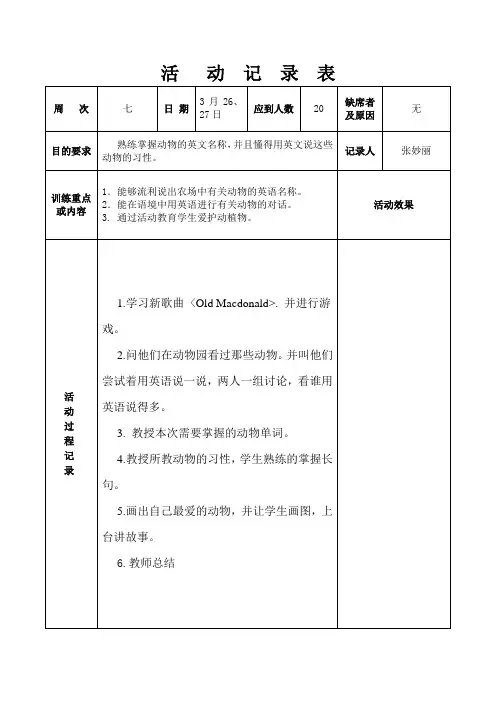
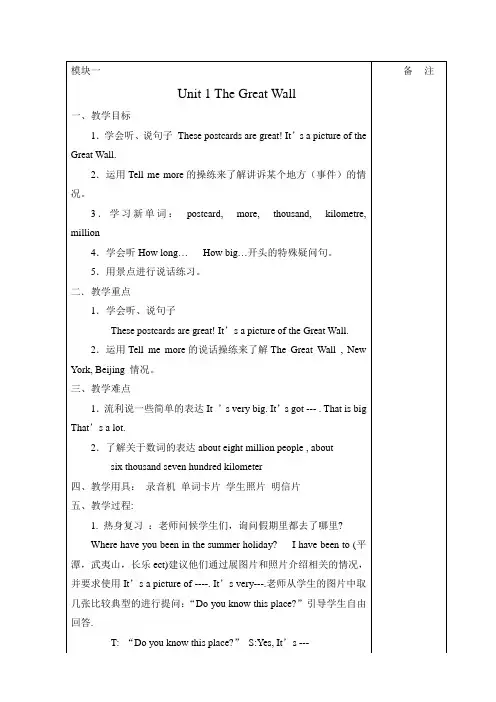
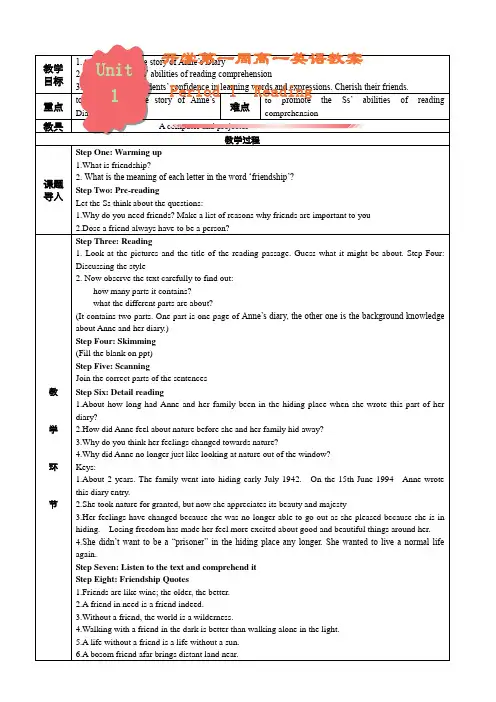
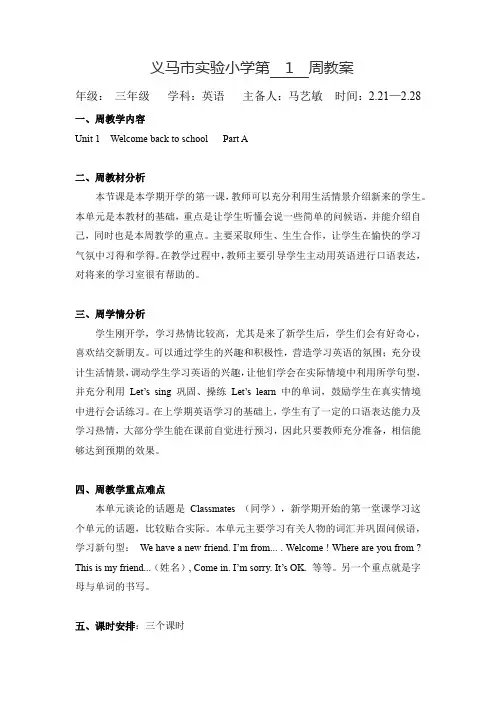
义马市实验小学第 1 周教案年级:三年级学科:英语主备人:马艺敏时间:2.21—2.28 一、周教学内容Unit 1 Welcome back to school Part A二、周教材分析本节课是本学期开学的第一课,教师可以充分利用生活情景介绍新来的学生。
本单元是本教材的基础,重点是让学生听懂会说一些简单的问候语,并能介绍自己,同时也是本周教学的重点。
主要采取师生、生生合作,让学生在愉快的学习气氛中习得和学得。
在教学过程中,教师主要引导学生主动用英语进行口语表达,对将来的学习室很有帮助的。
三、周学情分析学生刚开学,学习热情比较高,尤其是来了新学生后,学生们会有好奇心,喜欢结交新朋友。
可以通过学生的兴趣和积极性,营造学习英语的氛围;充分设计生活情景,调动学生学习英语的兴趣,让他们学会在实际情境中利用所学句型,并充分利用Let’s sing 巩固、操练Let’s learn 中的单词,鼓励学生在真实情境中进行会话练习。
在上学期英语学习的基础上,学生有了一定的口语表达能力及学习热情,大部分学生能在课前自觉进行预习,因此只要教师充分准备,相信能够达到预期的效果。
四、周教学重点难点本单元谈论的话题是Classmates (同学),新学期开始的第一堂课学习这个单元的话题,比较贴合实际。
本单元主要学习有关人物的词汇并巩固问候语,学习新句型:We have a new friend. I’m from... . Welcome ! Where are you from ? This is my friend...(姓名), Come in. I’m sorry. It’s OK. 等等。
另一个重点就是字母与单词的书写。
五、课时安排:三个课时第1课时第2课时第3课时。
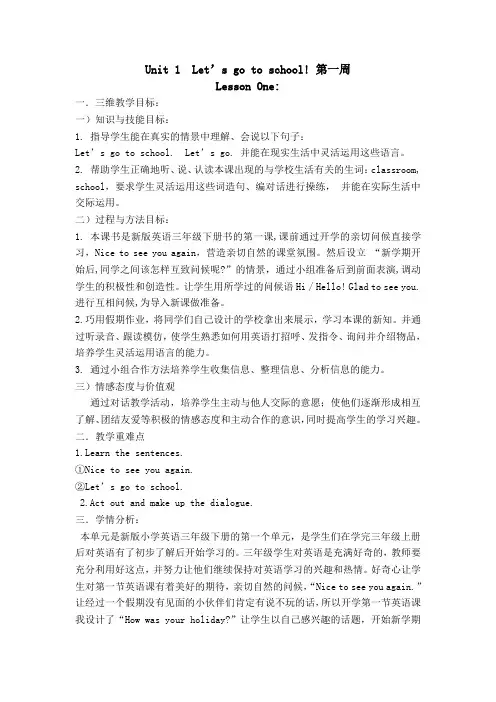
Unit 1 Let’s go to school! 第一周Lesson One:一.三维教学目标:一)知识与技能目标:1. 指导学生能在真实的情景中理解、会说以下句子:Let’s go to school. Let’s go. 并能在现实生活中灵活运用这些语言。
2. 帮助学生正确地听、说、认读本课出现的与学校生活有关的生词:classroom, school,要求学生灵活运用这些词造句、编对话进行操练,并能在实际生活中交际运用。
二)过程与方法目标:1. 本课书是新版英语三年级下册书的第一课,课前通过开学的亲切问候直接学习,Nice to see you again,营造亲切自然的课堂氛围。
然后设立“新学期开始后,同学之间该怎样互致问候呢?”的情景,通过小组准备后到前面表演,调动学生的积极性和创造性。
让学生用所学过的问候语Hi / Hello! Glad to see you.进行互相问候,为导入新课做准备。
2.巧用假期作业,将同学们自己设计的学校拿出来展示,学习本课的新知。
并通过听录音、跟读模仿,使学生熟悉如何用英语打招呼、发指令、询问并介绍物品,培养学生灵活运用语言的能力。
3. 通过小组合作方法培养学生收集信息、整理信息、分析信息的能力。
三)情感态度与价值观通过对话教学活动,培养学生主动与他人交际的意愿;使他们逐渐形成相互了解、团结友爱等积极的情感态度和主动合作的意识,同时提高学生的学习兴趣。
二.教学重难点1.Learn the sentences.①Nice to see you again.②Let’s go to school.2.Act out and make up the dialogue.三.学情分析:本单元是新版小学英语三年级下册的第一个单元,是学生们在学完三年级上册后对英语有了初步了解后开始学习的。
三年级学生对英语是充满好奇的,教师要充分利用好这点,并努力让他们继续保持对英语学习的兴趣和热情。
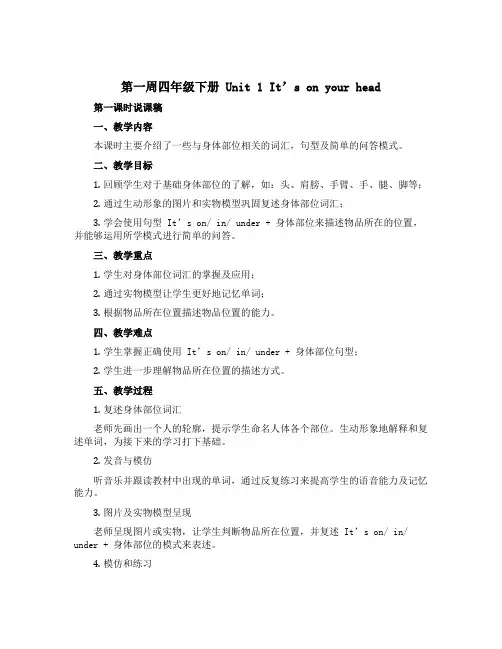
第一周四年级下册Unit 1 It’s on your head 第一课时说课稿一、教学内容本课时主要介绍了一些与身体部位相关的词汇,句型及简单的问答模式。
二、教学目标1.回顾学生对于基础身体部位的了解,如:头、肩膀、手臂、手、腿、脚等;2.通过生动形象的图片和实物模型巩固复述身体部位词汇;3.学会使用句型It’s on/ in/ under + 身体部位来描述物品所在的位置,并能够运用所学模式进行简单的问答。
三、教学重点1.学生对身体部位词汇的掌握及应用;2.通过实物模型让学生更好地记忆单词;3.根据物品所在位置描述物品位置的能力。
四、教学难点1.学生掌握正确使用It’s on/ in/ under + 身体部位句型;2.学生进一步理解物品所在位置的描述方式。
五、教学过程1.复述身体部位词汇老师先画出一个人的轮廓,提示学生命名人体各个部位。
生动形象地解释和复述单词,为接下来的学习打下基础。
2.发音与模仿听音乐并跟读教材中出现的单词,通过反复练习来提高学生的语音能力及记忆能力。
3.图片及实物模型呈现老师呈现图片或实物,让学生判断物品所在位置,并复述It’s on/ in/ under + 身体部位的模式来表述。
4.模仿和练习老师与学生进行模仿和练习,采用师生互动或小组协作的方式,让学生更好地记忆使用这些句型。
5.听写、检测教师听写单词或进行反馈,让学生更好地理解所学内容是否掌握,是否掌握了所学的概念及句型模式。
六、教学建议1.教师要注意提供足够的鼓励,让学生在学习过程中充满信心。
2.采用多种样式的图片和实物来巩固所学单词,提高学生的记忆能力。
3.在练习中多采用和学生互动的方式,促进学生积极主动地参与学习。
4.根据学生实际情况以及学生对这些词汇掌握的情况,可适当加大训练强度或缩小。
七、教学评估1.考试形式:如小测或口语。
2.评估内容:关于身体部位相关的词汇、句型以及简单的问答模式。
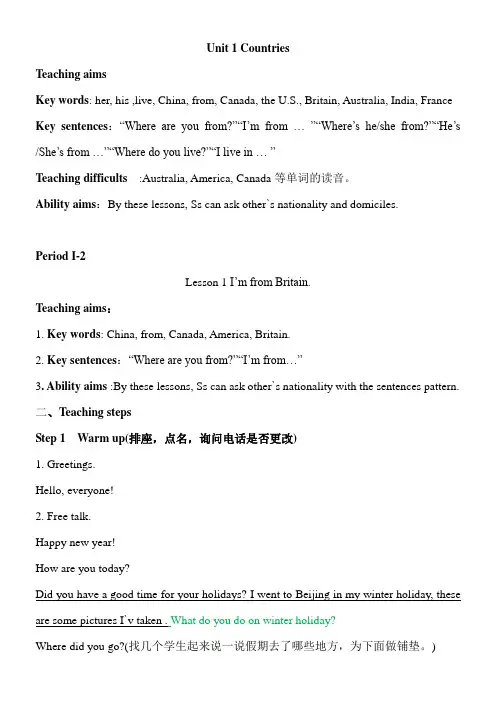
Unit 1 CountriesTeaching aimsKey words: her, his ,live, China, from, Canada, the U.S., Britain, Australia, India, France Key sentences:“Where are you from?”“I’m from … ”“Where’s he/she from?”“He’s /She’s from …”“Where do you live?”“I live in … ”Teaching difficults:Australia, America, Canada等单词的读音。
Ability aims:By these lessons, Ss can ask other`s nationality and domiciles.Period I-2Lesson 1 I’m from Britain.Teaching aims:1. Key words: China, from, Canada, America, Britain.2. Key sentences:“Where are you from?”“I’m from…”3. Ability aims :By these lessons, Ss can ask other`s nationality with the sentences pattern.二、Teaching stepsStep 1 Warm up(排座,点名,询问电话是否更改)1. Greetings.Hello, everyone!2. Free talk.Happy new year!How are you today?Did you have a good time for your holidays? I went to Beijing in my winter holiday, these are some pictures I`v taken . What do you do on winter holiday?Where did you go?(找几个学生起来说一说假期去了哪些地方,为下面做铺垫。
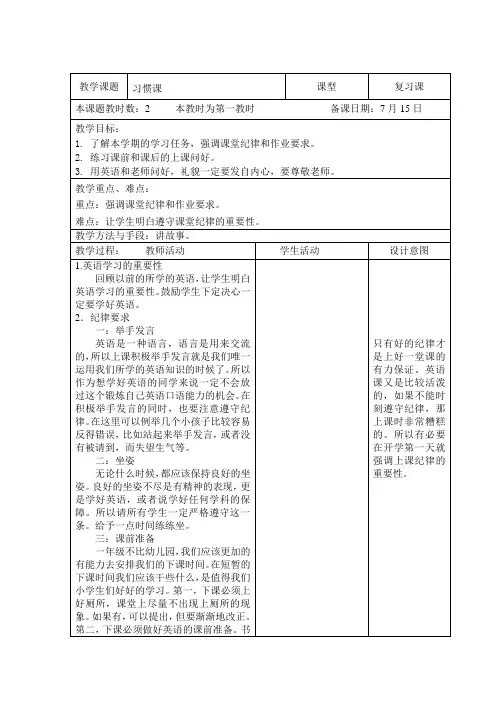
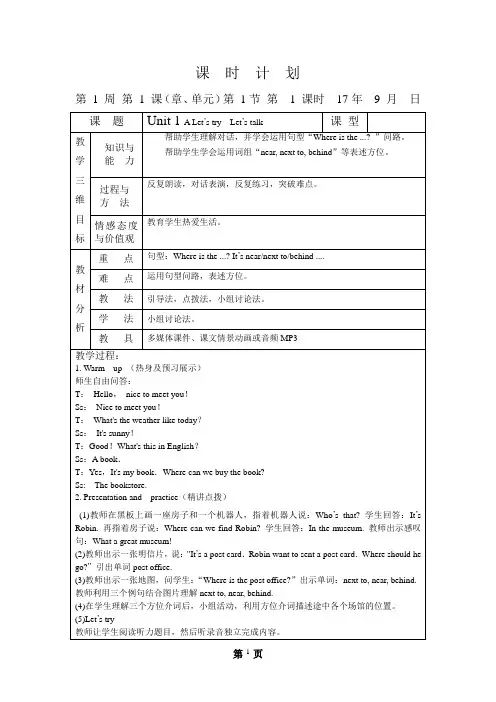
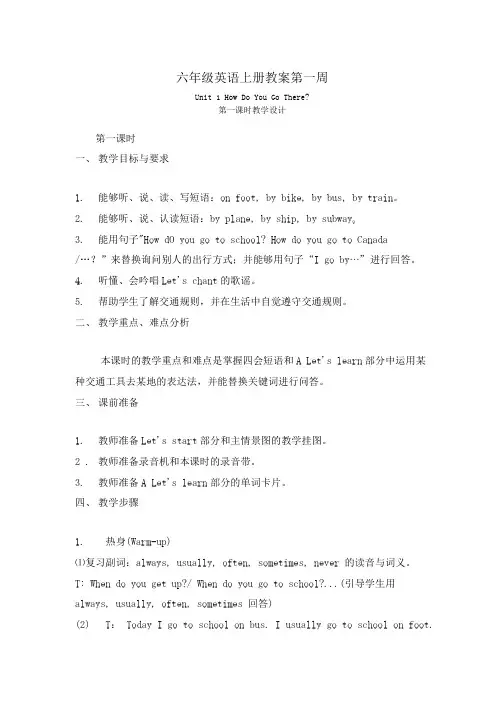
六年级英语上册教案第一周Unit 1 How Do You Go There?第一课时教学设计第一课时一、教学目标与要求1.能够听、说、读、写短语:on foot, by bike, by bus, by train。
2.能够听、说、认读短语:by plane, by ship, by subway o3.能用句子"How dO you go to school? How do you go to Canada/…?”来替换询问别人的出行方式;并能够用句子“I go by…”进行回答。
4.听懂、会吟唱Let's chant的歌谣。
5.帮助学生了解交通规则,并在生活中自觉遵守交通规则。
二、教学重点、难点分析本课时的教学重点和难点是掌握四会短语和A Let's learn部分中运用某种交通工具去某地的表达法,并能替换关键词进行问答。
三、课前准备1.教师准备Let's start部分和主情景图的教学挂图。
2 . 教师准备录音机和本课时的录音带。
3.教师准备A Let's learn部分的单词卡片。
四、教学步骤1.热身(Warm-up)⑴复习副词:always, usually, often, sometimes, never 的读音与词义。
T: When do you get up?/ When do you go to school?...(引导学生用always, usually, often, sometimes 回答)(2)T: Today I go to school on bus. I usually go to school on foot.教师利用肢体动作帮助学生理解句子意思。
T:What about you? Do you go by bike or by bus? Do you go on foot? Or by car?师生之间自由会话,引出几种常见的交通方式。
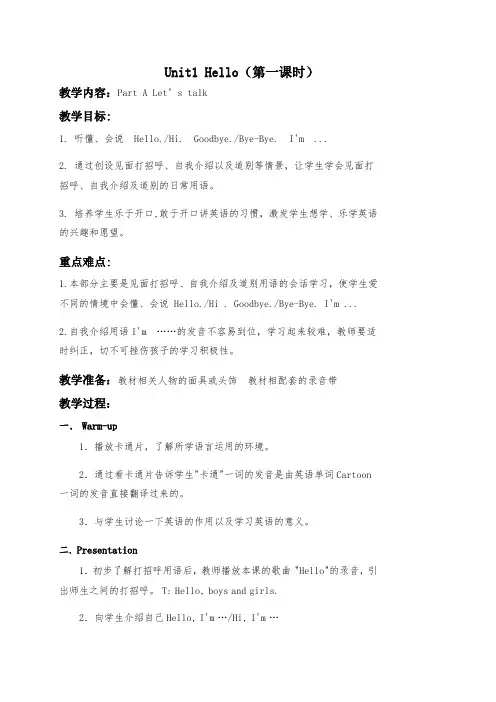
Unit1 Hello(第一课时)教学内容:Part A Let’s talk教学目标:1. 听懂、会说Hello./Hi. Goodbye./Bye-Bye. I'm ...2. 通过创设见面打招呼、自我介绍以及道别等情景,让学生学会见面打招呼、自我介绍及道别的日常用语。
3. 培养学生乐于开口,敢于开口讲英语的习惯,激发学生想学、乐学英语的兴趣和愿望。
重点难点:1.本部分主要是见面打招呼、自我介绍及道别用语的会话学习,使学生爱不同的情境中会懂、会说 Hello./Hi . Goodbye./Bye-Bye. I'm ...2.自我介绍用语I'm……的发音不容易到位,学习起来较难,教师要适时纠正,切不可挫伤孩子的学习积极性。
教学准备:教材相关人物的面具或头饰教材相配套的录音带教学过程:一.Warm-up1.播放卡通片,了解所学语言运用的环境。
2.通过看卡通片告诉学生"卡通"一词的发音是由英语单词Cartoon 一词的发音直接翻译过来的。
3.与学生讨论一下英语的作用以及学习英语的意义。
二.Presentation1.初步了解打招呼用语后,教师播放本课的歌曲"Hello"的录音,引出师生之间的打招呼。
T:Hello,boys and girls.2.向学生介绍自己Hello,I'm…/Hi,I'm…3.带上Sarah的头饰介绍Hello!I'm Sarah./Hi!I'm Sarah.4.听录音,录像展示Let's talk部分的教学内容三.Practice1.玩Let's play中的游戏"击鼓传花"。
提示学生发音,引导学生区分正确、错误的发音。
2.出示情景图,让他们自己说说,在此情景中该说些什么?让学生看书上的图,才图中人物,想他们在说什么。
学生带上面具,互相打招呼并介绍自己,复习本课所学知识。
英语一周教学计划Week 1: Introduction to EnglishDay 1: Introduction to the English LanguageIn this introductory lesson, students will learn about the importance of learning English as a global language. The teacher will explain the basic structure of the English language and introduce essential vocabulary related to greetings and introductions.Day 2: Phonetics and PronunciationThis lesson will focus on phonetic symbols and their corresponding sounds in English. Students will learn how to pronounce vowels, consonants, and diphthongs accurately. The teacher will provide practice activities to reinforce their understanding.Day 3: Grammar BasicsTo lay a solid foundation for future learning, students will be introduced to basic grammar rules, such as sentence structure and verb tenses. The teacher will use clear examples and interactive exercises to ensure comprehension.Day 4: Reading SkillsThis lesson will focus on improving reading skills through various activities. Students will be provided with English texts of appropriate difficulty levels and will be guided to understand the main ideas, context, and vocabulary within the passages.Day 5: Vocabulary BuildingIn this lesson, students will participate in vocabulary acquisition exercises. The teacher will provide word lists related to different topics and engage students in activities such as synonym/antonym identification, word association, and context-based usage.Week 2: Speaking and Listening DevelopmentDay 1: Oral Communication PracticeTo enhance speaking skills, students will engage in pair work and group discussions. The teacher will provide prompts that encourage students to express their opinions, share personal experiences, and engage in debates.Day 2: Listening ComprehensionThis lesson will focus on improving listening skills through various audio materials, such as dialogues, interviews, and news clips. Students will practice understanding the main ideas, identifying specific information, and recognizing different accents.Day 3: Presentation SkillsIn this lesson, students will learn how to effectively present information in English. The teacher will teach techniques for preparing and delivering presentations, including structuring content, using visual aids, and engaging the audience.Day 4: Listening and Speaking IntegrationTo reinforce listening and speaking skills, students will participate in interactive activities, such as role-plays, simulations, and storytelling. Theteacher will assess their performance and provide constructive feedback for improvement.Day 5: Debate and DiscussionStudents will engage in a debate or discussion on a given topic. They will employ critical thinking skills, express their opinions, and respond to counterarguments. The teacher will guide the discussion and facilitate a collaborative learning environment.Week 3: Writing PracticeDay 1: Sentence Structure and Paragraph WritingStudents will learn about sentence structure, including subject-verb agreement, sentence types, and sentence connectors. They will practice writing well-structured paragraphs using appropriate topic sentences and supporting details.Day 2: Descriptive WritingThis lesson will focus on descriptive writing techniques. Students will learn how to use vivid vocabulary, sensory details, and figurative language to create engaging descriptions. They will apply these skills by describing a person, place, or object of their choice.Day 3: Narrative WritingIn this lesson, students will explore narrative writing. They will learn about story elements, such as plot, characters, setting, and conflict. Students will have the opportunity to write their own narratives and share them with the class.Day 4: Persuasive WritingTo develop persuasive writing skills, students will learn about persuasive techniques, logical arguments, and counterarguments. They will practice writing persuasive essays on various topics and engage in peer evaluation.Day 5: Review and FeedbackThe final day of the week will be dedicated to reviewing the lessons covered so far. Students will receive individual feedback on their progress and areas for improvement. The teacher will address any lingering questions or concerns.By implementing this comprehensive one-week English teaching plan, students will gain a solid foundation in the language, improve their communication skills, and develop proficiency in various language domains. Continuous practice and reinforcement will be essential for their ongoing English language development.。
教学目标:1. 让学生熟悉大学英语课程的学习要求和方法。
2. 培养学生基本的英语听说读写能力。
3. 增强学生对英语学习的兴趣和自信心。
教学内容:1. 课程介绍2. 学习方法与技巧3. 英语基础知识复习4. 第一单元课文学习教学时间:2课时教学过程:第一课时一、导入(5分钟)1. 教师简要介绍大学英语课程的重要性,以及本学期的学习目标和计划。
2. 提问学生:为什么选择学习英语?对英语学习有什么期望?二、课程介绍(10分钟)1. 介绍大学英语课程的设置、教学大纲、教材和考核方式。
2. 强调课堂参与、课后练习和自主学习的重要性。
三、学习方法与技巧(15分钟)1. 阅读技巧:快速浏览、定位信息、理解大意。
2. 听力技巧:抓住关键词、理解主旨、预测下文。
3. 口语技巧:发音、语调、流利度。
4. 写作技巧:结构清晰、内容丰富、语法正确。
5. 鼓励学生积极提问,分享自己的学习方法。
四、英语基础知识复习(20分钟)1. 复习英语字母、音标、基本语法知识。
2. 通过练习题帮助学生巩固基础知识。
第二课时一、复习第一课时内容(10分钟)1. 回顾学习方法与技巧,强调重点内容。
2. 检查学生对英语基础知识的掌握情况。
二、第一单元课文学习(40分钟)1. 介绍第一单元课文主题,激发学生学习兴趣。
2. 预习课文,让学生了解课文大意。
3. 集体朗读课文,纠正发音和语调。
4. 分析课文结构,讲解重点词汇和句型。
5. 课堂讨论,引导学生思考课文内容。
6. 练习翻译课文,巩固所学知识。
三、课堂小结(10分钟)1. 回顾本节课所学内容,强调重点。
2. 布置课后作业,包括课文阅读、听力练习、口语练习和写作练习。
教学评价:1. 观察学生在课堂上的参与度和积极性。
2. 检查学生的课后作业完成情况。
3. 定期进行英语水平测试,了解学生的学习进度。
教学反思:1. 根据学生的学习情况,调整教学内容和方法。
2. 关注学生的学习兴趣,激发学生的学习动力。
小学三年级英语上册教案Unit 1Lesson 1教学目标:1、听懂、会说Hello./Hi . Goodbye./Bye-Bye. I'm ...。
2、通过创设见面打招呼、自我介绍以及道别等情景,让学生学会见面打招呼、自我介绍及道别的日常用语3、培养学生乐于开口,敢于开口讲英语的习惯,激发学生想学、乐学英语的兴趣和愿望。
教材分析:在本课时主要学习见面打招呼、自我介绍及道别用语Hello./Hi . Goodbye./Bye-Bye. I'm ...。
为此,教师为学生创设见面打招呼、自我介绍以及道别等情景,使学生了解英语常用用语以及使用环境。
教学中,除让学生听懂以上日常用语以外,还应让学生敢说、会说。
学生对于打招呼和道别用语Hello./Hi . Goodbye./Bye-Bye. 的发音比较熟悉,而对于自我介绍用语I'm ...的发音不容易到位,学习起来较难,教师要适时纠正,切不可挫伤孩子的学习积极性。
教法建议:通过聊天、讨论还可以让学生了解一些学习英语的作用和意义。
可利用教科书开始的蝴蝶页Welcome to English 的彩图,为学生呈现我们生活中已经会说或较熟悉的词汇如CD, VCD, DVD, OK! Hi! Yeah! Wow! Bye! Cartoon, Mickey等等来激发学生想学英语的兴趣。
引导学生自主学习"变要我学为我要学"。
教师在讲授本课的打招呼、自我介绍及道别用语时,可以先给学生播放卡通片,了解所学语言运用的环境。
在巩固操练时,教师可采取交谈的方式与学生聊天,用英语和他们打招呼、自我介绍,并告知Hello./Hi是英语中常用的打招呼用语,甚至让学生自己说说这些语言都运用在哪些情景中。
教师还可用击鼓传花、角色扮演等游戏来练习。
最后教师可引导学生创设生活情景,实现真正的语言交流。
教学重点:本部分主要是见面打招呼、自我介绍及道别用语的会话学习,使学生在不同的情景中听懂、会说Hello./Hi . Goodbye./Bye-Bye. I'm ...。